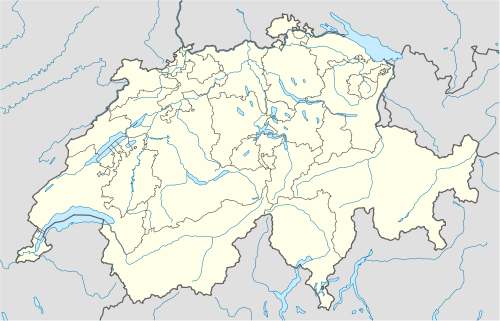Albligen
| Albligen | ||
|---|---|---|
| Former municipality of Switzerland | ||
| ||
 Albligen | ||
|
Location of Albligen  | ||
| Coordinates: 46°51′N 7°19′E / 46.850°N 7.317°ECoordinates: 46°51′N 7°19′E / 46.850°N 7.317°E | ||
| Country | Switzerland | |
| Canton | Bern | |
| District | Bern-Mittelland | |
| Government | ||
| • Mayor | Regula Reinhardt-Trachsel | |
| Area | ||
| • Total | 4.3 km2 (1.7 sq mi) | |
| Elevation | 699 m (2,293 ft) | |
| Population | ||
| • Total | 477 | |
| • Density | 110/km2 (290/sq mi) | |
| Postal code | 3183 | |
| SFOS number | 0851 | |
| Surrounded by | Ueberstorf, Wahlern, Heitenried | |
| Website |
www SFSO statistics | |
Albligen (former French name: Albenon) is a former municipality in the Bern-Mittelland administrative district in the canton of Bern in Switzerland. On 1 January 2011, the former municipalities of Wahlern and Albligen merged in the new municipality of Schwarzenburg.
History
Albligen is first mentioned in 1346 as Alblingen.[1]
Geography
Albligen has an area, as of 2009, of 4.29 km2 (1.66 sq mi). Of this area, 2.41 km2 (0.93 sq mi) or 56.2% is used for agricultural purposes, while1.49 km2 (0.58 sq mi) or 34.7% is forested. Of the rest of the land, 0.32 km2 (0.12 sq mi) or 7.5% is settled (buildings or roads), 0.06 km2 (15 acres) or 1.4% is either rivers or lakes.[2]
Of the built up area, industrial buildings made up 0.0% of the total area while housing and buildings made up 4.9% and transportation infrastructure made up 2.3%. 32.6% of the total land area is heavily forested and 2.1% is covered with orchards or small clusters of trees. Of the agricultural land, 26.6% is used for growing crops and 27.7% is pastures, while 1.9% is used for orchards or vine crops. All the water in the municipality is in rivers and streams.[2]
Albligen lies in the midland of a small bank in the Höchi hills (818 m (2,684 ft) above sea level). On the eastern edge of the municipality flows the Sense River.
The neighboring municipalities are Ueberstorf, Wahlern, and Heitenried.
Demographics
Albligen has a population (as of 31 December 2010) of 477.[3] As of 2007, 3.2% of the population was made up of foreign nationals. Over the last 10 years the population has decreased at a rate of -5.7%. Most of the population (as of 2000) speaks German (97.5%), with French being second most common ( 1.4%) and Romanian being third ( 0.4%).
In the 2007 election the most popular party was the SVP which received 50% of the vote. The next three most popular parties were the SPS (19.3%), the Green Party (9.6%) and the local small left-wing parties (7.8%).
The age distribution of the population (as of 2000) is children and teenagers (0–19 years old) make up 26.5% of the population, while adults (20–64 years old) make up 60.5% and seniors (over 64 years old) make up 13%. In Albligen about 74.4% of the population (between age 25-64) have completed either non-mandatory upper secondary education or additional higher education (either University or a Fachhochschule).
Albligen has an unemployment rate of 0.75%. As of 2005, there were 59 people employed in the primary economic sector and about 20 businesses involved in this sector. 16 people are employed in the secondary sector and there are 7 businesses in this sector. 27 people are employed in the tertiary sector, with 10 businesses in this sector.[4] The historical population is given in the following table:[1]
| year | population |
|---|---|
| 1850 | 694 |
| 1960 | 421 |
| 1990 | 442 |
References
- ↑ 1.0 1.1 Albligen in German, French and Italian in the online Historical Dictionary of Switzerland.
- ↑ 2.0 2.1 Swiss Federal Statistical Office-Land Use Statistics 2009 data (German) accessed 25 March 2010
- ↑ Swiss Federal Statistical Office - STAT-TAB, online database – Datenwürfel für Thema 01.2 - Bevölkerungsstand und -bewegung (German) accessed 29 September
- ↑ Swiss Federal Statistical Office accessed 13-Jul-2009
External links
| Wikimedia Commons has media related to Albligen. |
- Dubler, A-M: Albligen in German, French and Italian in the online Historical Dictionary of Switzerland, 2005-06-14.
